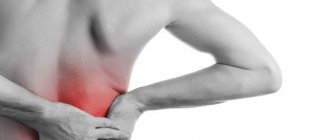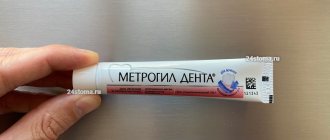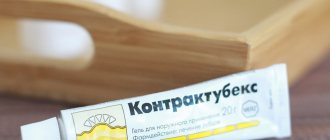Pharmacological properties of the drug Dolobene
Combined preparation for external use. Dimethyl sulfoxide has an anti-inflammatory, anti-exudative and local analgesic effect due to the inactivation of hydroxyl radicals and improvement of metabolic processes in the site of inflammation, reducing the speed of nociceptive impulses in peripheral neurons, as well as the presence of hygroscopic properties; facilitates the resorption of other ingredients of the drug. Heparin is a direct anticoagulant, a natural anticoagulant of the body, has an anti-inflammatory effect, promotes the regeneration of connective tissue by inhibiting the activity of hyaluronidase; prevents thrombus formation, activates fibrinolytic properties of blood; improves local blood flow. Dexpanthenol, a derivative of vitamin B5, is converted in the skin into pantothenic acid, which is part of coenzyme A, which plays an important role in the processes of acetylation and oxidation. By improving metabolic processes, it promotes the regeneration of damaged tissues. After a single application of 1.5 g of Dolobene to a skin surface area of 4 cm2, dimethyl sulfoxide is resorbed with an absorption half-life of 3–4 hours. 6 hours after application, its concentration in the blood reaches approximately 120 ng/ml, a level that persists for 12 hours. Period half-life from blood plasma is 11–14 hours. 60 hours after application, the level of dimethyl sulfoxide corresponds to its endogenous concentration in blood plasma as a natural substance of the body (on average 40 ng/ml). Dimethyl sulfoxide passes into breast milk. Eliminated primarily in urine. Heparin sodium does not cross the placental barrier and does not enter breast milk. The pharmacokinetics of dexapanthenol have not been studied.
Composition and dosage form
Dolobene is produced in the form of a gel: a homogeneous viscous substance of a yellowish color. Packaged in metal tubes of 50 and 100 ml. Designed for application to the skin. Contains a combination of 3 active components:
- dimethyl sulfoxide: relieves pain, reduces inflammation and swelling;
- heparin: stimulates tissue regeneration, reduces thrombosis;
- dexpanthenol: accelerates the recovery and epithelization of damaged cells.
Dolobene also contains auxiliary and stabilizing components: rosemary, pine, citronella oils, water, isopropyl alcohol, polyacrylic acid, Cremophor.
Use of the drug Dolobene
For adults and children over 5 years of age, apply the gel in a thin layer (for example, a column of gel 3 cm long is applied to an area the size of which corresponds to the projection of the knee joint) on or around the affected areas (for abrasions), evenly distributed over the surface of the skin with light rubbing movements 2 –4 times a day. When applying dressings with Dolobene gel, a breathable dressing material is used only after most of the gel has penetrated the skin and the alcohol contained in the preparation has evaporated (several minutes). When using the ion-phoretic method of drug administration, the gel is applied under the cathode, taking into account the anionic properties of heparin, which is part of Dolobene. In phonophoresis, the preparation, which is a suitable contact gel and contains active substances, complements the physiotherapeutic effect of ultrasonic waves. The duration of treatment for Dolobene is individual and depends on the severity of the disease, as well as the effectiveness of therapy.
How Dolobene works
The substance is quickly absorbed through the stratum corneum and dermis upon application. The active ingredients reach the subcutaneous tissue, accelerate microcirculation and metabolic processes, and block the conductivity of pain receptors in the affected area. Heparin and dimethyl sulfoxide inhibit the activity of the enzyme Hyaluronidase, which supports inflammation. Dexpanthenol is converted into pantothenic acid, an analogue of a natural compound that regulates redox processes in tissues and accelerates their healing.
In the deep layers of the skin, subcutaneous tissue and joint structures, the active substances of the gel are concentrated 5–6 hours after application. With daily use of the medicine, their content in tissues increases. In this case, the therapeutic effect is local. The drug is absorbed into the systemic circulation in small quantities. Metabolites are excreted within 12–24 hours by the kidneys.
Side effects of the drug Dolobene
Possible skin hyperemia, itching and burning sensation at the site of application of the drug; temporary appearance of garlicky breath (due to the presence of dimethyl sulfide, a metabolite of dimethyl sulfoxide). This smell indicates good absorption of dimethyl sulfoxide. Changes in taste sensations, which sometimes occur immediately after applying the gel, usually disappear after a few minutes. Isolated cases of the development of immediate allergic reactions (urticaria, Quincke's edema) have been described.
What is Dolobene used for: instructions
The drug is used to eliminate pain, inflammation and swelling due to mechanical damage and joint pathologies:
- dislocations of limbs;
- bruises;
- ligament ruptures;
- traumatic hematomas;
- periarthritis of the shoulder joints;
- neuralgia;
- exacerbations of arthrosis of the knee joints;
- tendinitis and tendovaginitis (tendon inflammation);
- lumbago;
- exacerbations of osteochondrosis.
Dolobene is also used in ultrasound therapeutic procedures to enhance wave conduction: iontophoresis and phonophoresis.
Mandatory condition: in places where the gel is applied to the skin there should be no open lesions, boils and neoplasms, fresh scars, or dermatitis.
Special instructions for the use of the drug Dolobene
To prevent unwanted effects, the drug is applied to clean skin. Other medications should not be applied for several hours before or after using Dolobene. The drug should not be applied to the mucous membrane, wound surface or damaged skin (for example, after irradiation, with dermatitis, dermatoses, postoperative scars, burns). The drug does not leave an oily sheen on the skin or marks on clothes. After applying the drug, a feeling of coolness occurs (due to the alcohol content).
Who is contraindicated for Dolobene gel?
It is necessary to stop using the drug:
- for chronic obstructive pulmonary disease;
- bronchial asthma;
- malignant oncological diseases;
- cardiovascular pathologies;
- severe renal failure;
- individual hypersensitivity to the components of the gel.
Dolobene should not be used to treat children under 5 years of age. Due to the possible toxic effect on the fetus, the product is not recommended for use by pregnant women. Metabolites of dimethyl sulfoxide can pass into breast milk. Therefore, during lactation the drug should also be abandoned.
Effect of the drug
The product is recommended for use in various conditions accompanied by the appearance of hematomas and pain. Its effectiveness is due to the action of the components:
WE RECOMMEND THE ARTICLE!
Troxerutin ointment is used for chronic venous insufficiency. Read more >>
- Dimexide,
after entering the cells, reduces the activity of hydroxyl radicals. These substances appear during an inflammatory reaction and have a destructive effect on body tissue. As a result of the use of the gel, a pronounced anti-inflammatory effect is observed. Dimexide eliminates pain - it reduces the speed of pain impulses passing along the nerve roots. Also, this component of Dolobene gel optimizes the subcutaneous reaction of processing hydroxyl radical decomposition products, which helps reduce swelling. - Heparin
inhibits the enzyme hyaluronidase, resulting in improved metabolism and reparative processes in connective tissue. The main effect of heparin as an anticoagulant is the inhibition of antithrombin 3, due to which it resolves hematomas and bruises. - Dexpanthenol
after contact with the skin is transformed into pantothenic acid. Without this substance, tissue regeneration is difficult. After penetration into cells, pantothenic acid accelerates the processes of granulation and epithelialization.
Thanks to Dimexide in the composition, the medicine easily penetrates cell membranes, therefore, all components reach the inflammation zone and begin to work.
The product in combination has anti-inflammatory, antiexudative, analgesic, antithrombotic, and regenerating effects.
The half-life of the components is 11-14 hours; dimexide is eliminated the longest (up to 48% of the product is lost in the form of metabolites within a week).
[media=
https://youtu.be/o5VXqkvGoGM
]
Indications and contraindications for Dolobene
Various pathologies, for which Dolobene ointment helps, belong to the field of traumatology, orthopedics and other areas of medicine. The main indications are traumatic damage to tissue integrity:
- bruises;
- inflammation in soft tissues;
- inflammation in tendons, ligaments;
- hematomas, bruises;
- closed injuries (without skin damage);
- swelling of tissues;
- traumatic damage to joints and bones;
- sprains;
- sports injuries.
Dolobene is also successfully used against various diseases of the musculoskeletal system. The indications are as follows:
- osteochondrosis, hernias, protrusions;
- arthrosis, various types of arthritis;
- tendonitis, tendovaginitis;
- periarthritis of the humerus;
- epicondylitis, tennis elbow.
In neuralgia, Dolobene is used against acute inflammatory processes in the peripheral nervous system. Dolobele is often prescribed for pain in the legs due to thrombophlebitis, thrombosis, varicose veins, and periphlebitis.
For a number of pathologies, the drug is recommended in complex therapy along with other systemic and local agents.
Among the main contraindications are severe heart disease, vascular disease, bronchial asthma, renal and liver failure.
You cannot treat Dolobene with open wounds
, under the age of 6 years, during pregnancy, lactation, allergies to active ingredients.
Dolobene - composition, description
Medicine Dolobene
produced in the form of
a gel (ointment)
for external use, weight - 50, 100 g. The drug belongs to the group of direct-acting anticoagulants, therefore it is widely used as a absorbable, decongestant. The gel helps with pain and hematomas, damage to tendons and joints.
Externally, the drug substance is a gel-like mass - colorless or yellowish. The composition of the drug is represented by the following substances:
- Dexpanthenol
. Cell regenerator, has a dermatoprotective effect. - Heparin sodium
. Anticoagulant, prevents blood clotting. - Dimethyl sulfoxide
. Another name is dimexide, it is an anti-inflammatory, analgesic agent.
The product contains a number of additional components:
- rosemary oil;
- mountain pine oil;
- purified water;
- polyacrylic acid;
- citronella (lemongrass) oil;
- isopropanol;
- trometamol;
- cremophor.
After penetration into the skin layers, Dolobene begins to act immediately, due to which it quickly removes pain and swelling. The drug can be stored at room temperature. Dolobene is available without a prescription. The price of the medicine is 370 rubles/50 g.




